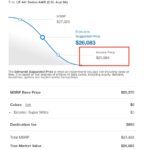Purchasing a used car can be an exciting endeavor, but it’s crucial to approach it with caution and due diligence. One of the most important aspects of buying a used vehicle is ensuring it has a clean title. A clean title signifies that the car has not been declared a total loss or sustained significant damage that could compromise its safety or value. Understanding how to verify a car’s title is clean is essential to protect yourself from potential financial and legal headaches down the road. This guide will walk you through the steps to confidently check for a clean title and make informed decisions when buying a used car.
Understanding a Car Title and Why it Matters
A car title is a legal document that establishes ownership of a vehicle. It contains vital information about the car, including its vehicle identification number (VIN), make, model, and year. More importantly, the title records any brands or notations that indicate the car’s history, such as accidents, flood damage, or salvage declarations. A clean title means there are no brands on the title that suggest significant damage or issues. Conversely, a branded title indicates the vehicle has experienced something that negatively impacts its value and potentially its safety.
Driving a car with a branded title can lead to several problems:
- Reduced Resale Value: Cars with branded titles are worth significantly less than those with clean titles.
- Safety Concerns: Salvage or rebuilt titles may hide underlying structural or mechanical issues resulting from accidents or disasters.
- Insurance and Financing Difficulties: Some insurance companies may be hesitant to fully cover branded title vehicles, and securing financing can also be more challenging.
Therefore, knowing how to check for a clean title is not just about avoiding lemons; it’s about making a sound investment and ensuring your safety on the road.
Key Steps to Check for a Clean Title
Checking for a clean title involves several crucial steps that should be performed before finalizing any used car purchase.
1. Request and Carefully Examine the Physical Title Document
The first step is to ask the seller to provide the physical car title. Examine it closely for any signs of alterations, erasures, or inconsistencies. Pay attention to the following:
- Title Brands: Look for any terms printed on the title that indicate a brand. These can vary by state but commonly include terms like “Salvage,” “Rebuilt,” “Flood Damage,” “Water Damage,” “Junk,” “Manufacturer Buyback,” or “Not Actual Mileage.” The presence of any of these brands signals that the title is not clean.
- Seller Information: Ensure the seller’s name on the title matches their identification and that they are legally entitled to sell the vehicle.
- Vehicle Information: Verify that the VIN on the title matches the VIN on the car’s dashboard (usually visible through the windshield on the driver’s side) and the VIN sticker on the driver’s side doorjamb. Any discrepancies could be a red flag.
- Watermarks and Security Features: Genuine titles often have watermarks, security threads, or special paper. Familiarize yourself with your state’s title security features to spot potential forgeries.
Referencing the original article, here are explanations of some title brands you might encounter:
- Salvage: Indicates the vehicle was severely damaged, and the cost to repair it exceeded a certain percentage of its pre-damage value. Such vehicles can be rebuilt and retitled.
- Rebuilt: Signifies a vehicle that was previously salvaged but has been repaired and passed inspections to be roadworthy again. While legal to drive, rebuilt vehicles may still have hidden issues and lower value.
- Water Damage/Flood Damage: Means the vehicle was damaged by flooding. Flood-damaged cars can suffer from long-term electrical and mechanical problems.
- Junk: This brand is assigned to vehicles deemed permanently unusable for driving and only valuable for scrap or parts. Junk titles should never be registered or titled again.
- Manufacturer Buyback/Warranty Return: Indicates the vehicle was returned to the manufacturer under warranty, often due to recurring problems (lemon law buyback).
2. Obtain a Vehicle History Report
While examining the physical title is important, it may not always reveal the full history of the vehicle, especially if the title brandings occurred in a different state. A vehicle history report is a crucial tool to uncover potential title issues and historical damage. Reputable providers like Carfax or AutoCheck compile data from various sources, including DMV records, insurance companies, and salvage auctions, to generate a comprehensive report.
A vehicle history report can reveal:
- Title Brands: It will list any title brands recorded in any state, even if the current physical title appears clean. This is vital as title washing (illegally cleaning a branded title by moving it to a different state) is a known issue.
- Accident History: Reports accidents reported to the police or insurance companies, which may not always result in a branded title but can still indicate damage.
- Odometer Discrepancies: Highlights potential odometer rollback, a fraudulent practice to make a high-mileage car appear newer.
- Service and Repair History: May provide information on reported maintenance and repairs.
- Theft Records: Indicates if the vehicle has ever been reported stolen.
Important Note: Always obtain a vehicle history report from a reputable provider yourself. Do not rely solely on a report provided by the seller, as it could be manipulated or incomplete.
3. Consider a Pre-Purchase Inspection
Even with a clean title and a seemingly clear vehicle history report, a pre-purchase inspection by a qualified mechanic is highly recommended. A mechanic can identify hidden mechanical or structural issues that may not be apparent to the untrained eye or documented in reports. This is especially important for older vehicles or those with any red flags in their history.
Conclusion: Protect Yourself with Due Diligence
Ensuring a car has a clean title is a critical step in the used car buying process. By carefully examining the physical title, obtaining a vehicle history report, and considering a pre-purchase inspection, you can significantly reduce the risk of buying a vehicle with hidden problems or a compromised history. Taking these proactive steps will empower you to make a confident and informed decision, protecting your investment and ensuring peace of mind on the road.

